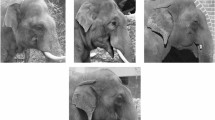Summary
Evoked potentials were recorded to the separate tachistoscopic presentation of a variety of faces and other simple and complex visual stimuli. A positive potential of 150–200 ms peak latency which responds preferentially, but not exclusively, to faces was identified in 8 out of 9 subjects. This potential, best recorded from midline central and parietal electrodes, was evoked by all face stimuli, including photographs, outline drawings, and fragmentary figures. Changes in stimulus size and other parameters which do not affect the clarity of the face, generally had little effect on the peak amplitude. Stimulus changes such as face inversion, reversing the contrast polarity of photographic images, and selectively removing particular facial features, produced a marked increase in latency but often only slight attenuation of this peak. These response properties correspond well with those reported for face-related single cells in the temporal cortex of the rhesus monkey. The scalp distribution of this face-responsive peak also appears consistent with bilateral sources in the temporal cortex.
Similar content being viewed by others
References
Baylis GC, Rolls ET, Leonard CM (1985) Selectivity between faces in the responses of a population of neurons in the cortex in the superior temporal sulcus of the monkey. Brain Res 342:91–102
Bötzel K, Grüsser O-J (1987) Potentials evoked by face and nonface stimuli in the human electroencephalogram. Perception 16:A21
Bruce C, Desimone R, Gross CG (1981) Visual properties of neurons in a polysensory area in superior temporal sulcus of the Macaque. J Neurophysiol 46:369–384
Damasio AR (1985) Prosopagnosia. Trends Neurosci 8:132–135
Desimone R, Albright TD, Gross CG, Bruce C (1984) Stimulus-selective properties of inferior temporal neurons in the macaque. J Neurosci 4:2051–2062
Hillyard SA, Picton TW (1979) Event-related brain potentials, and selective information processing in man. In: Desmedt JE (ed) Cognitive components in cerebral event-related potentials and selective attention. Karger, Basel, pp 1–52
Homan RW, Herman J, Purdy P (1987) Cerebral location of international 10–20 system electrode placement. Electroenceph Clin Neurophysiol 66:376–382
Jeffreys DA (1977) The physiological significance of pattern visual evoked potentials. In: Desmedt J (ed) Visual evoked potentials in man: new developments. Clarendon Press, Oxford, pp 134–167
Jeffreys DA (1989) Evoked potential studies of contour processing in human visual cortex. In: Kulikowski JJ, Dickinson CM (eds) Contour and colour. Pergamon, London, pp 525–541 (in press)
Jeffreys DA, Axford JG (1972) Source locations of patternspecific components of human visual evoked potentials. I. Component of striate cortical origin. II. Component of extrastriate cortical origin. Exp Brain Res 16:1–40
Jeffreys DA, Musselwhite MJ (1987) A face-responsive visual evoked potential in man. J Physiol 390:26P
Jeffreys DA, Murphy F, Musselwhite MJ (1986) Human pattern-evoked potentials recorded with textured backgrounds. J Physiol 382:97P
Jeffreys DA, Musselwhite MJ, Murphy F (1987) A study of the late components of the pattern-onset VEP. Electroenceph Clin Neurophysiol 67:51P
Leeper R (1935) A study of a neglected portion of the field of learning — the development of sensory organization. J Gen Psychol 46:41–75
Maunsell JHR, Newsome WT (1987) Visual processing in monkey extrastriate cortex. Ann Rev Neurosci 10:363–401
Musselwhite MJ, Jeffreys DA (1982) Pattern-evoked potentials and Bloch's law. Vision Res 22:897–903
Mooney CM (1957) Age in the development of closure ability in children. Can J Psychol 11:219–226
Nunez PL (1981) Electric fields of the brain. Oxford University Press, New York
Parkin AJ, Williamson P (1987) Cerebral lateralization at different stages of facial processing. Cortex 23:99–110
Perrett DI, Rolls ET, Caan W (1982) Visual neurones responsive to faces in the monkey temporal cortex. Exp Brain Res 47:329–342
Perrett DI, Smith PAJ, Potter DD, Mistlin AJ, Head AS, Milner AD, Jeeves MA (1984) Neurones responsive to faces in the temporal cortex: studies of functional organization, sensitivity to identity and relation to perception. Hum Neurobiol 3:197–208
Perrett DI, Smith PAJ, Potter DD, Mistlin AJ, Head AS, Milner AD, Jeeves MA (1985) Visual cells in the temporal cortex sensitive to face view and gaze direction. Proc R Soc Lond B223:293–317
Perrett DI, Mistlin AJ, Chitty AJ (1987) Visual neurones responsive to faces. Trends Neurosci 10:358–364
Regan D (1989) Human brain electrophysiology: evoked potentials and evoked magnetic fields in science and medicine. Elsevier, Amsterdam
Rolls ET (1984) Neurons in the cortex of the temporal lobe and in the amygdala of the monkey with responses selective to faces. Hum Neurobiol 3:209–222
Rolls ET, Baylis GC, Leonard CM (1985) Role of low and high spatial frequencies in the face-selective responses of neurons in the cortex in the superior temporal sulcus in the monkey. Vision Res 25:1021–1035
Rolls ET, Baylis GC (1986) Size and contrast have only small effects on the responses to faces of neurons in the cortex of the superior temporal sulcus of the monkey. Exp Brain Res 65:38–48
Rolls ET, Baylis GC, Hasselmo ME (1987) The responses of neurons in the cortex in the superior temporal sulcus of the monkey to band-pass spatial frequency filtered faces. Vision Res 27:311–326
Small M (1983) Asymmetrical evoked potentials in response to face stimuli. Cortex 19:441–450
Srebro R (1985a) Localization of visually evoked cortical activity in humans. J Physiol 360:233–246
Srebro R (1985b) Localization of cortical activity associated with visual recognition in humans. J Physiol 360:247–260
Street RF (1931) A Gestalt completion test. Teachers College, Columbia University, New York
Vaughan HG, Ritter W (1970) The sources of auditory evoked responses recorded from the human scalp. Electroenceph Clin Neurophysiol 28:360–367
Author information
Authors and Affiliations
Rights and permissions
About this article
Cite this article
Jeffreys, D.A. A face-responsive potential recorded from the human scalp. Exp Brain Res 78, 193–202 (1989). https://doi.org/10.1007/BF00230699
Received:
Revised:
Accepted:
Issue Date:
DOI: https://doi.org/10.1007/BF00230699




